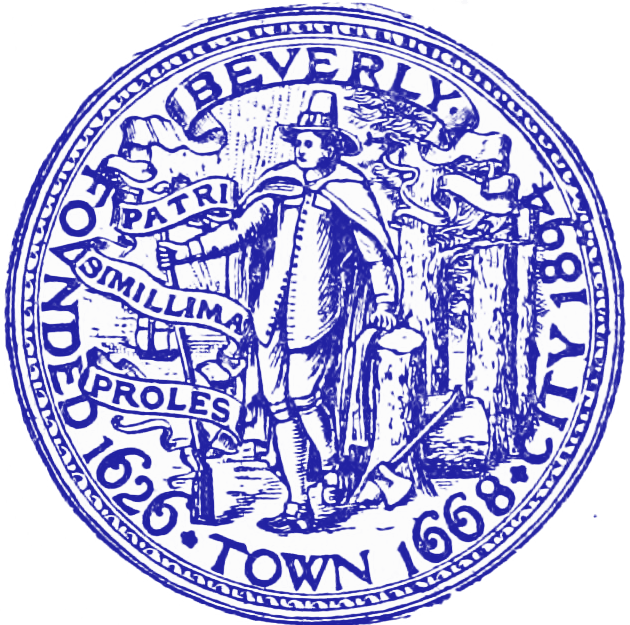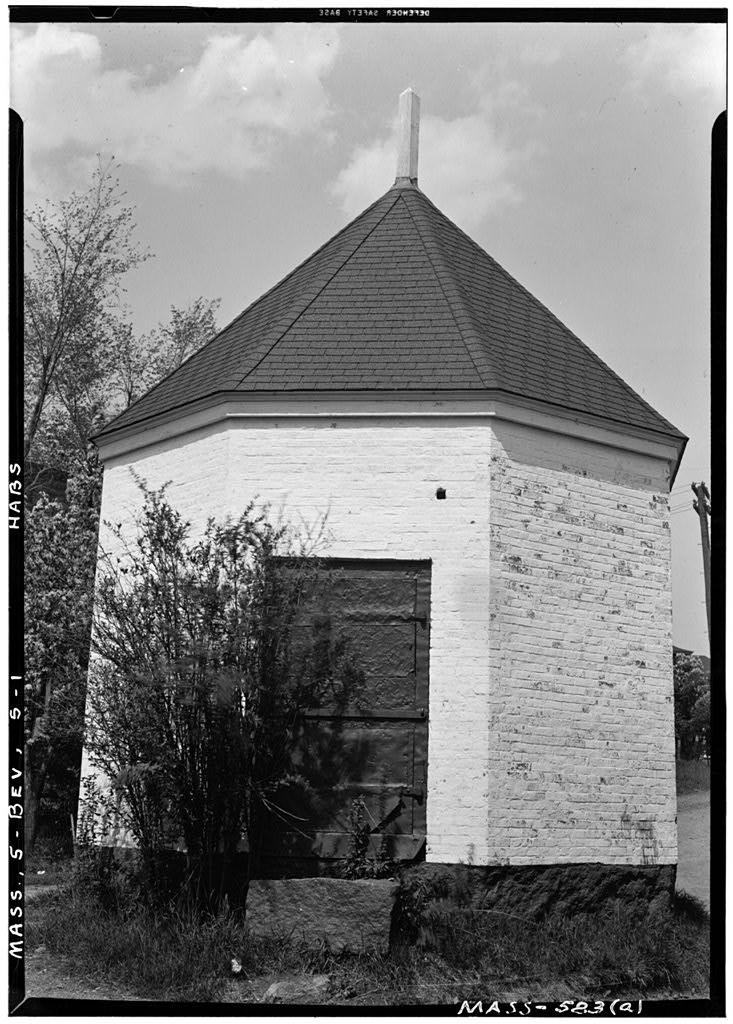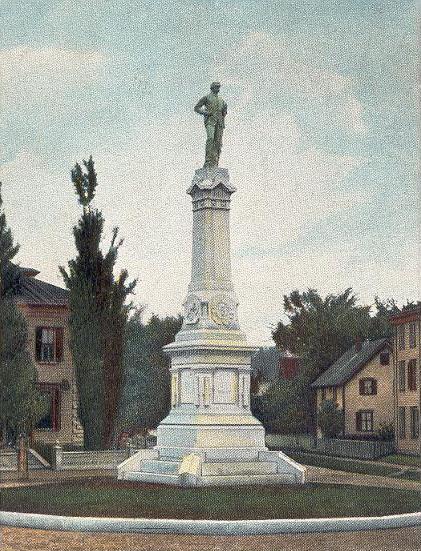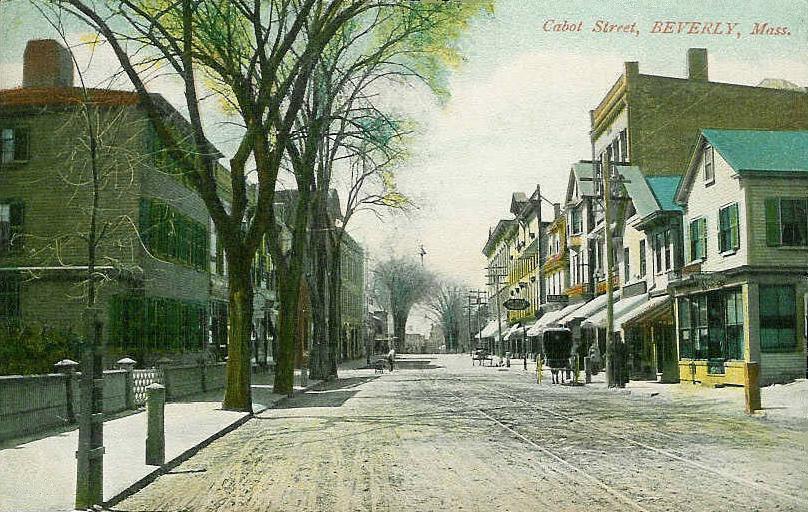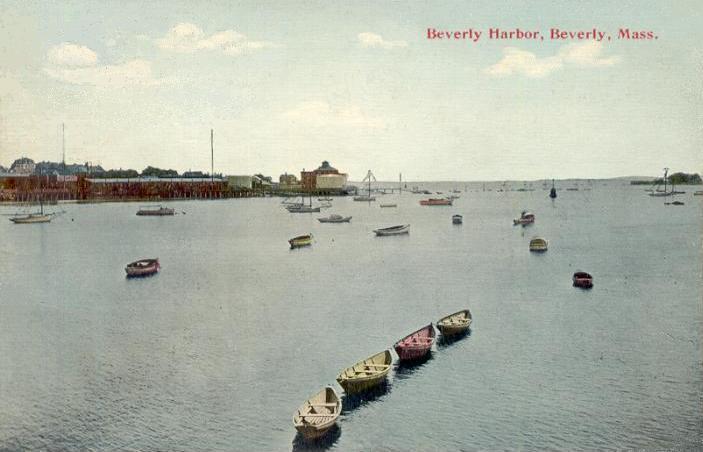Beverly is a historic town located in Essex County in Massachusetts. Beverly was once a part of Salem but later separated from it in the mid 17th-century when it was incorporated as its own town in the Massachusetts Bay Colony.
The following is a timeline of the history of Beverly:
1635:
- Roger Conant, John Balch, Peter Palfrey, John Woodbury and Peter Trask petition the town of Salem for a land grant on the other side of the river, known as the Bass River Side, which is now modern day Beverly. The grant was approved and each man was allotted 200 acres of farmland.
1636:
- A ferry to Salem is established on the Danvers River.
1644:
- The William Dodge House, a Colonial-style house, is built on Lyman Street.
1646:
- Hale Street is established.
1650:
- A cottage is built for Cornelius Larcom on what is now Hale Street.
1668:
- Beverly is incorporated as a town in the Massachusetts Bay Colony.
1672:
- The first school house is built on the Southwest corner of Beverly Common. The school house doubles as a watch house.
1673:
- The John Grover House, a Colonial-style house, is constructed on Cabot Street.
1675:
- The William Cleaves House, a Colonial-style house, is built for William Cleaves on Essex Street.
1676:
- The William Woodberry house, a Colonial-style house, is built for William Woodberey sometime between 1676 – 1685 on Essex Street.
1677:
- The Ancient Burial Ground is established on Abbott Street as a burial ground for the First Parish Church.
1679:
- The John Balch House is built on Cabot Street.
1685:
- The John Woodberry House, a Colonial-style house, is built on Dodge Street.
1686:
- The Hazadiah Smith House, a Colonial-style house, is constructed by carpenter Hazadiah Smith on Cabot Street.
- The Nathaniel Stone House, a Colonial-style house, is built for farmer Nathaniel Stone on Essex Street.
1688:
- The Lieutenant John Balch House, a Colonial-style house, is built on Dodge Street.
- The William Haskell – Robert Haskell House, a Colonial-style house, is built on Hale Street.
1691:
- The Green Family Burial Ground is established on Rowell Avenue.
1694:
- The Reverend John Hale House, a Colonial-style house, is built for Beverly’s first minister Reverend John Hale on what is now Hale Street.
- The John Patch House, a Colonial-style house, is built on Hale Street.
1695:
- The Exercise Conant House, a Colonial-style house, is built on what is now Cabot Street.
- The Peter Woodbury House, a Colonial-style house, is built for Deacon Peter Woodbury Jr on Dodge Street.
1699:
- The Robert Woodberry House, a Colonial-style house, is built sometime between 1699 – 1707 for Robert Woodberry on Hale Street.
1700:
- The Samuel Corning House, a Georgian-style house, is constructed on Hull Street.
- The William Livermore House, a Colonial-style house, is built on Essex Street.
1701:
- The Captain Robert Briscoe Warehouse, a Colonial-style building, is constructed on Front Street.
1702:
- The Captain John Thorndike House, a Colonial-style house, is built on Hale Street.
1705:
- The Dodge Burial Ground is established on Dodge Street.
- The town purchases two and three quarter acres of land from John Giles, Elizer Giles and John Wheeler to expand Beverly Common on Essex Street.
1706:
- The Isaac Hull Jr House, a Colonial-style house, is built for Isaac Hull Jr on what is now Hull Street.
- The John Dodge House, a Georgian-style house, is built for John Dodge on what is now Dodge Street.
1708:
- The John Wheeler House, a Colonial-style house, is built on Hale Street.
1711:
- A watch house is constructed on Paul’s Point on the west side of Beverly Cove.
1714:
- North Parish Church – North Meeting House is built on Conant Street.
1715:
- Nehemiah Wood House, a Colonial / Georgian-style house, is built for cordwainer Nehemiah Wood on Dodge Street.
1716:
- The Beverly Grammar School, a Colonial-style schoolhouse, is built on Essex Street.
1717:
- The Conant Street Burial Ground is established on Conant Street.
- The Colonel Henry Herrick House, a Colonial-style house, is built on Cabot Street.
1722:
- The Robert Thorndike House, a Colonial-style house, is built for Robert Thorndike on Hale Street.
1723:
- The John Tuck House is constructed on Silver Court.
- The John Thorndike Jr House and the Paul Thorndike Jr House is built on Hale Street.
- The Peter Pride House, a Colonial-style house, is built for Peter Pride on Hale Street.
- The William Woodberry House, a Colonial-style house, is built for William Woodberry on Ober Street.
1734:
- The Priscilla Patch House, a Colonial-style house, is built on Hale Street.
- The Hugh Woodberry House, a Federal-style house, is built on Ober Street.
- The Herbert Thorndike House is built on Hale Street.
- The Nathaniel Wallis House, a Colonial-style house, is built on Woodbury Street.
1738:
- The Robert Patch House, a Colonial-style house, is built on Standley Street.
1750:
- The Captain John Stevens House, a Georgian-style house, is built on Davis Street.
- The Captain Zachariah Stone Inn, a Georgian-style house, is built on Front Street.
- The Captain Livermore Whittredge Estate, a Georgian-style house, is built on Front Street.
- The Herrick Tavern is built on Front Street.
1753:
- The Israel Green House, a Colonial-style house, is built on Harris Street.
1760:
- The John Flaunt House, a Colonial-style house, is built on Conant Street.
- The Mary and Peter Kelleher House is built on Winter Street.
1764:
- The Captain Nathan Leech House, a Georgian-style house, is built on Bartlett Street.
- The Colonel Larkin Thorndike House, a Colonial-style house, is built on Hale Street.
- The George Raymond House, a Colonial-style house, is built on New Balch Street.
- The Captain Edmund Giles House, a Georgian-style house, is built on Front Street.
1765:
- The Captain Josiah Batchelder Jr House, a Georgian-style house, is built for Captain Josiah Batchedlar Jr on Front Street.
1767:
- The town’s first powder and gun house are built on the south side of Beverly Common. It had a cooper sheathed door and long slating iron roof.
- The Lieutenant John Wallis House, a Colonial-style house, is built on Bow Street.
1768:
- The David Williams House is built on Bridle Path Lane.
- The David Williams House, a Federal-style house, is built on Hart Street.
1770:
- The First Parish Church, a Greek Revival-style church building, is constructed on Cabot Street.
- The Joanna Batchelder Prince House, a Georgian-style house, is built for the surveyor of the Beverly port Josiah Batchelder on Front Street. His daughter, Joanna, later established the first Sunday School in America in the house in 1810.
1771:
- The Jonathan Smith House, a Colonial-style house, is built on Cabot Street.
1772:
- The Ezra Ober House, a Colonial-style house, is built for merchant Ezra Ober and his wife Joanna on Hale Street.
- The Sergeant Joseph Foster House, a Colonial-style house, is built on Railroad Ave.
1773:
- The William Lovett House, a Colonial-style house, is built on Franklin Place.
1774:
- The Elizabeth Cabot House, a Federal-style house, is built for the widow Elizabeth Cabot on Central Street.
1775:
- On October 10, the schooner USS Hannah is chased into Beverly harbor by the British warship the Nautilus. Local militia turn out and began firing on the Nautilus which fires its cannons at the Hannah and the town of Beverly. The battle ends in a stalemate after the Nautilus becomes grounded when the tide goes out. The Nautilus finally leaves Beverly harbor on the next tide.
- The Jacob Thompson House, a Georgian-style house, is built on Bartlett Street.
1778:
- The West Farms School, a Colonial-style school building, is constructed on Front Street.
1779:
- The Captain William Morgan House is built on Front Street.
1780:
- The Lieutenant Daniel Wallis House, a Colonial-style house, is built on Cabot Street.
- The Captain Zachariah Morgan House is built on Cabot Street.
- The Luther West House is built on Cabot Street.
- The Dixie Woodbury House is built on Hale Street.
- The I. Thissell House is built on Essex Street.
- The Captain Hugh Hill House, a Georgian-style house, is built on Front Street.
1781:
- The Captain John Cabot House, a late Georgian/early Federal-style brick mansion, is built for ship owner Captain John Cabot on what is now Cabot Street.
- The Francis Yates House, a Federal-style house, is built on Cabot Street.
- The Captain John Cabot House, a Federal-style house, is built on Cabot Street.
1782:
- The William Tuck House, a Federal-style house, is built on Cabot Street.
1783:
- The Andrew Cabot House, a brick Federal-style house, is built for Andrew Cabot on what is now Cabot Street.
- The Francis Lamson House, a Georgian-style house, is constructed for Francis Lamson on Lovett Street.
1785:
- The Andrew Thorndike House is built on Hale Street.
- The Smith – Adams House, a Colonial-style house built as a duplex, is built for Adam Smith and Moses Adams on Central Street.
1787:
- The Zachariah Batchelder House, a Federal-style house, is built on Conant Street.
- The Andrew Elliot House, a Colonial-style house, is built for Andrew Elliott on what is now Elliott Street.
1788:
- The Essex River Bridge is built on what is now Bridge Street.
- The Captain John Hammond House, a Colonial-style house, is built for John Hammond on Franklin Place.
1789:
- The John Smith House, a Colonial-style house, is built on Bennett Street.
- The Captain Thomas Bridges House is built on Front Street.
- The Hugh Hill House, a Georgian-style house, is constructed for Captain Hugh Hill on Front Street.
1790:
- The Joseph Tuck House, a Federal-style house, is built on Cabot Street.
- The Robert Stone House, a Federal-style house, is built on Davis Street.
- The population of Beverly is 3,290.
1791:
- The Josiah Foster Chapman House, a Federal-style house, is built on Brackenberry Lane.
- The Ebenezer Rogers House is built on Essex Street.
- The Herrick House is built on Front Street.
1792:
- The John Baxter Allen House, a Federal-style house, is constructed for Joseph Baker Jr and John Baxter Allen on Cabot Street.
1793:
- A new schoolhouse is built on Beverly Common.
- The W.H. Perry House is built on Briscoe Street.
1794:
- The David Thomas House is built on Winter Street.
- The John Dodge Jr House is built on Bartlett Street.
1795:
- West Street is established.
- The Amos Lefavour House, a Federal-style house, is built on Essex Street.
- The William Fornis House, a Colonial-style house, is built for William Fornis on Essex Street.
1797:
- The Nathaniel Treadwell Shop is constructed on Cabot Street.
- The Robert and Liberty Perry House, a Colonial-style house, is built for Robert and Liberty Perry on Hale Street.
- The Captain Hugh Hill Soap and Candle Factory Warehouse is constructed on Water Street.
- The John Francis House, a Federal-style house, is built on Roosevelt Street.
1798:
- The Samuel Stickney Jr House, a Federal-style house, is built between 1798 and 1811 for cabinet maker Samuel Stickney Jr on Cabot Street.
1799:
- The William Norton House, a Federal-style house, is built for local baker William Norton on School Street.
1800:
- The population of Beverly is 3,881.
1801:
- A smallpox hospital is constructed on Paul’s Point on Bayview Ave.
1803:
- The Beverly Poor House is constructed on Summit Ave.
1806:
- The Unitarian Chapel is built on Hale Street.
1809:
- The Beverly Powder House, a brick storage building used to store gunpowder, is built on Madison Ave.
1810:
- The population of Beverly is 4,608.
1812:
- The smallpox hospital at Paul’s Point on Bayview Ave is converted into barracks.
1820:
- The population of Beverly is 4,283.
1830:
- The population of Beverly is 4,073.
1831:
- The Israel Trask Brittaniaware Shop is constructed on Cabot Street.
1833:
- The Dane Street Congregational Church is built on Dane Street.
1837:
- The Washington Street Congregational Church is built on Washington Street.
1839:
- The Beverly Depot is constructed by the Eastern Railroad on Park Street.
- Bell Hall, a Federal-style building that serves as a meeting hall, is built on Cabot Street.
1840:
- The Beverly Farms Cemetery is established on Hart Street.
- The population of Beverly is 4,689.
1841:
- The Second Baptist Society Church Parsonage is built on Hart Street.
- The Andrew Cabot House on Cabot Street is purchased by the city and converted into a town hall.
1844:
- The North Shore Community Baptist Church is built on Hart Street.
1849:
- The former smallpox hospital on Paul’s Point on Bayview Ave is destroyed in a fire.
1850:
- The population of Beverly is 5,376.
1852:
- Odell Park is constructed on Rantoul Street.
- The Eliott and Stanley Shoe Shop is built on Essex Street.
1853:
- The Union Hall building, a Greek Revival-style building, is constructed for the New England Protective Union on Cabot Street.
1860:
- The population of Beverly is 6,154.
1863:
- The First Calvanistic Baptist Church Chapel is built on Dane Street.
1868:
- The Salem and Beverly Waterworks is built on Dodge Street.
1869:
- The D. Lefavour and Sons Shoe Factory, an Italianate-style building that serves as a factory, is constructed on Rantoul Street.
1870:
- The Centerville Schoolhouse, an Italianate-style school house, is built on Essex Street.
- Cushing’s Carriage Manufactory Building is constructed on Rantoul Street.
- The population of Beverly is 6,507.
1871:
- The Hospital Point Lighthouse is constructed on Paul’s Point on Bayview Ave.
- The Louer Hose House No. 5 is built on Hale Street.
1872:
- The B.E. Cole Shoe Factory, an Italianate-style building that serves as a factory, is constructed on Rantoul Street.
- The Beverly Hose House No. 1 is built on River Street.
1873:
- The Briscoe Building, a High Victorian-style school building, is constructed on Essex Street.
1875:
- The Odd Fellows Hall, a Venetian Gothic-style building that serves as a meeting hall, is constructed on Cabot Street.
1876:
- Hatch and Mitchell’s Grocery Store is built on Cabot Street.
1879:
- Pride’s Crossing Railroad Station, a Stick Style train station building, is built on Hale Street.
1880:
- Lothrop Street is established.
- Stone Street is established.
- The Oliver Wendell Holmes House, a Victorian-style house, is built for Asa Obear Marshall on Hale Street and is later sold to Justice Oliver Wendell Holmes Jr in 1909.
- The Centerville Firehouse is built on Essex Street.
- The Saint Margaret Roman Catholic Church Convent is constructed on Hale Street.
- The population of Beverly is 8,456.
1882:
- The Soldiers and Sailors Monument is erected on Abbott Street. The monument is a 36-foot-tall granite statue of a Union soldier that is dedicated to the soldiers from Beverly who died in the Civil War.
1884:
- The Charles H. Creesy Shoe Factory is built on Park Street.
- The Cleaveland House, a Second Empire-style building that serves as a hotel, is constructed for Darling L. Trafton on Railroad Ave and is later renamed Hotel Trafton in 1895.
1885:
- The Beverly Railroad Drawbridge is built over the Danvers River.
- The Atlantic Block, a Victorian eclectic-style commercial building, is built on Cabot Street.
1886:
- The David S. Lynch Memorial Park is established on Ober Street.
- The Salem and Beverly Waterworks is built on Pershing Ave.
1887:
- The Chubb Creek Railroad Bridge is built over Chubb Creek.
- The Saint Margaret Roman Catholic Church is built on Hale Street.
- The Stopford Block, an Italianate-style commercial building, is constructed on Railroad Ave.
1888:
- The Episcopal Church Parsonage is built on Abbott Street.
1889:
- The Association Factories, four brick factory buildings, are constructed sometime between 1889 – 1895 for the Beverly Building Association on Rantoul Street.
1890:
- The Parramatta, a Colonial-style mansion, is built by Henry W. Peabody on Coming Street and is later rented by President William Taft in 1911 and 1912 for use as a summer house.
- The Cityside Diner is built on Cabot Street.
- The population of Beverly is 10,821.
1891:
- The Burnham Building, a Queen Anne-style commercial building, is constructed on Cabot Street.
- The Southwick Block, a Queen Anne-style commercial building, is built on Cabot Street.
- The Beverly Light Infantry Armory is built on Thorndike Street.
1892:
- The Beverly Gas and Electric Company is built on River Street.
1894:
- The Joseph F. Appleton Building, an Italianate-style building that later served as a hotel, is constructed on Rantoul Street.
1895:
- The Woodbury Shoe Company factory is constructed on Rantoul Street.
- Neighbors’ Hall, a Shingle style building that serves as a meeting hall, is built on West Street.
1896:
- The Pleasant Street Railroad Bridge is built on Pleasant Street.
- The J.P. Friend and Company Box Factory is constructed on Pleasant Street.
1897:
- The Essex Bridge is rebuilt on Bridge Street.
- The Marston and Sturtevant Grocers Building, a Victorian Eclectic-style commercial building, is constructed on Cabot Street.
1898:
- The Hardie School is built on Essex Street.
- The Beverly Farms Railroad Station is constructed by the Eastern Railroad on Oak Street.
1899:
- The John Girdler Coal and Wood Building is constructed on Cabot Street.
- The Crosby Block, a Classical Revival-style commercial building, is built on Rantoul Street.
1900:
- The E.N. Tuttle and Company Complex is constructed on Rantoul Street.
- The population of Beverly is 13,884.
1902:
- Saint John’s Episcopal Church is built on Hale Street.
1903:
- The Endicott Building, a Colonial Revival-style commercial building, is constructed on Cabot Street.
- The Beverly Savings Bank is built on Cabot Street.
- The Centerville Hose House No. 4 is built on Essex Street.
- The United Shoe Machinery Plant is constructed on Elliott Street.
1904:
- The Beverly Farms School, a Colonial Revival-style building, is built on Haskell Street.
1905:
- Woodbury Street Park is constructed on Woodbury Street.
- Hose House No. 2, a brick French Renaissance-style fire house, is built on Rantoul Street.
- Hotel Beverly, a Colonial Revival-style building that serves as a hotel, is constructed on Mill Street.
- The Hose House No. 2 is built on Rantoul Street.
- The Henry C. Moore Bath House is constructed on Paine Place.
- Clogston’s Corner, a Colonial Revival-style commercial building, is built on Rantoul Street.
1906:
- Saint Margaret Roman Catholic Church Rectory is built on Hale Street.
1907:
- The Earle T. Wardell Park is constructed on Colon Street.
- The Kernwood Bridge is built Kernwood Ave.
- A firehouse is constructed for the Beverly Fire Department on Dodge Street.
- The Beverly Hospital is built on Herrick Street.
- The Winslow School – McKay Street School, a Colonial Revival-style building, is constructed on McKay Street.
- The Upton Machine shop is built on River Street.
- The Centerville Christian Endeavor Church is built on Standley Street.
- The Edwin C. Swift is built on Paine Place.
1908:
- Saint Mary’s Church is built on Cabot Street.
1909:
- Church of the Nazarene is built on Rantoul Street.
1910:
- The Washington – Beadle Elementary School, a Classical Revival-style school building, is built on Elliott Street.
- The Beverly Main Branch of the U.S. Post Office is built on Rantoul Street.
- The population of Beverly is 18,650.
1911:
- The United Shoe Machinery Plant is built on Elliott Street.
1912:
- The Dane Street Congregational Church Parsonage is built on Dane Street.
- The Abraham Edwards Elementary School, a Colonial Revival-style school building, is built on Rantoul Street.
- The Larcom Theater is built on Wallis Street.
1913:
- The Appleton Building, a Classical Revival-style commercial building, is built on Cabot Street.
- The Beverly Public Library is built on Essex Street.
1914:
- The Butman Block is built on Cabot Street.
- The Beverly Farms Village Post Office is built on West Street.
1915:
- The Beverly Trust Company Branch Bank is constructed on Hale Street.
- The Gusto Face is built on Cabot Street.
1916:
- The Beverly Farms Branch Library is built on Vine Street.
1917:
- The Ryal Side Fire Station is built on Bridge Street.
- The Laura Shuman Memorial Home, a summer camp building dedicated to the memory of Laura Shuman, is built on Standley Street.
1918:
- The World War I Monument is erected at The Earle T. Wardell Park on Colon Street.
1920:
- The Atomic Cafe is built on Cabot Street.
- The Ware Theater is built on Cabot Street.
- The Brown School – Bass River School is Conant Street.
- The Memorial United Methodist Church is built on Dane Street.
- The population of Beverly is 22,561.
1923:
- The Beverly High School – Briscoe Middle School is built on Sohier Road.
1924:
- The Saint Mary’s Star of the Sea School is built on Chapman Street.
- The Beverly School for the Deaf is built on Echo Ave.
1925:
- The Liberty Masonic Building is constructed on Cabot Street.
- The Saint Margaret Church – Association Assembly Hall is built on Hale Street.
1926:
- The Beverly Fireman’s Relief Memorial is erected in the Central Cemetery on Hale Street. The memorial is a granite slab with a bas relief of a fireman in full uniform.
1929:
- The Bass River Bridge is built on Bridge Street.
- The Beverly Manor is built on Broadway.
- The Saint Margaret Roman Catholic Parochial School is built on Hale Street.
1930:
- The population of Beverly is 25,086.
- The Dalton Electric Company building is constructed on Front Street.
1932:
- The Beverly Times Building is constructed on Cabot Street.
- Monsterrat College is constructed on Cabot Street.
1934:
- The Beverly Public Works Department Complex is built on Park Street.
1937:
- The Salem and Beverly Waterworks is constructed on Salem Road.
1940:
- The population of Beverly is 25,537.
1942:
- The First National Store is built on Cabot Street.
1945:
- The United Shoe Machinery Corporation Sawmill is built on Elliott Street.
1946:
- The Sons of Abraham Synagogue is constructed on Bow Street.
1950:
- The population of Beverly is 28,884.
- The Central Fire Station and Signal Tower are built on Hale Street.
1952:
- The Memorial Junior High School is built on Cabot Street.
1954:
- The Beverly Cooperative Bank is built on Cabot Street.
1955:
- The Beverly National Bank is built on Cabot Street.
- The People’s United Bank is built on Cabot Street.
1956:
- The Church in the Cove is built on Hale Street.
- The Beverly Farms Police Station is built on West Street.
1957:
- The Saint Mary’s Star of the Sea Convent is built on Chapman Street.
1960:
- Saint Alphonsus Roman Catholic Church Rectory is built on Elliott Street.
- Scott’s Furniture store is built on Cabot Street.
- The population of Beverly is 36,108.
1961:
- The Temple B’nai Abraham is constructed on East Lothrop Street.
1964:
- The Immanuel Congregational Church is constructed on Bridge Street.
1970:
- The population of Beverly is 38,348.
1980:
- The population of Beverly is 37,655.
1990:
- The Beverly Korean War Memorial is established at Odell Park on Rantoul Street.
- The population of Beverly is 38,195.
1992:
- The Beverly World War I Memorial and World War II Memorial is established at Odell Park on Rantoul Street.
2000:
- The population of Beverly is 39,862.
2010:
- The population of Beverly is 39,502.
2020:
- The population of Beverly is 42,670.
Sources:
Lapham, Alice Gertrude. The Old Planters of Beverly in Massachusetts & The Thousand Acre Grant of 1635. Applewood Books, 1930.
“Beverly History.” Historic Beverly, historicbeverly.net/about/beverly-history
MACRIS, Massachusetts Cultural Resource Information System, Massachusetts Historical Commission, mhc-macris.net

